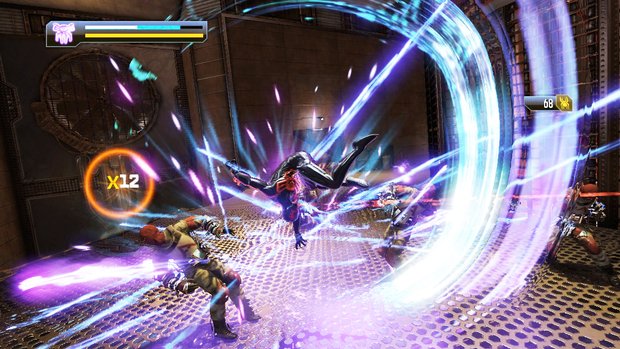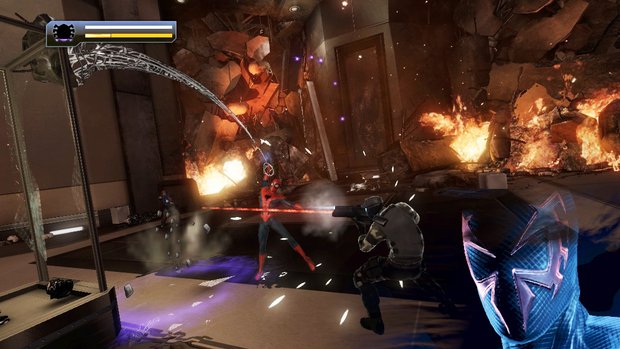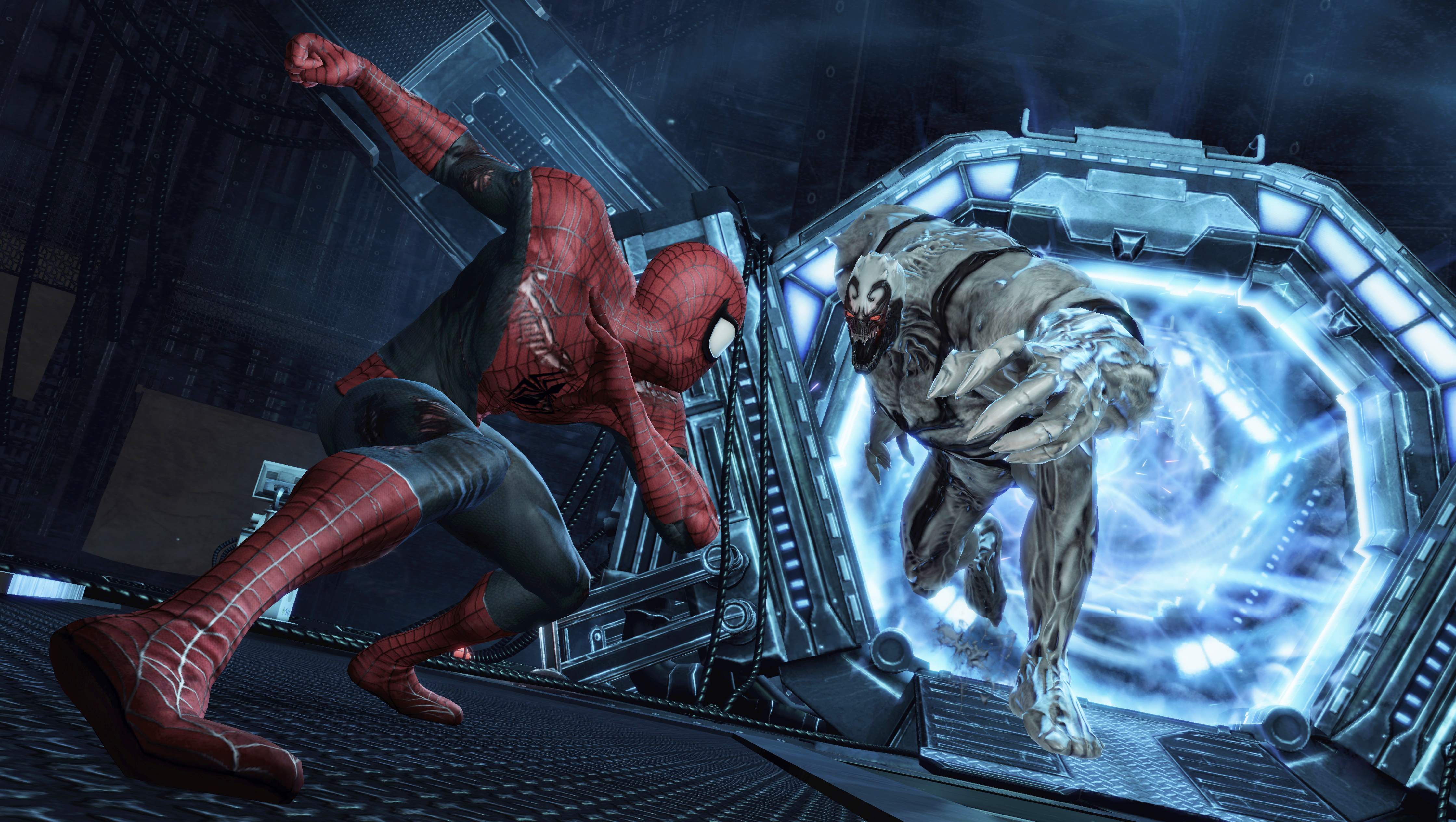GamesRadar+ Verdict
Pros
- +
Interresting premise
- +
Best looking in-game Spider-Man costume to date
- +
Fun dialogue between Spideys
Cons
- -
Boring level design
- -
Lame enemies
- -
Fails to live up to potential
Why you can trust GamesRadar+
For years there have been good to great Spider-Man games that were based on sources diverse as movies, TV shows, and alternate universe comics. Still, over the last few years it seems like Spidey has been spinning his wheels more than his webs. 2010’s Spider-Man: Shattered Dimensions was a clever idea, as you jumped across universes playing as four different Spider-Men, but four Spideys didn’t add up to more than the sum of its parts. Now its pseudo-sequel Spider-Man: Edge of Time is here with half the dimensions as it focuses on the current Peter Parker and his counterpart in the far-flung 2099 trying to save the future one paradox at a time.
The trouble begins when a 2099 tech industrialist (voiced by Val Kilmer) sends himself back in time to conquer corporations in the past using his future knowledge, creating an even more dystopian future than Spider-Man 2099 is used to. Good thing future Spidey found a seemingly illogical way to communicate with current day Spider-Man so they can work together across fluctuating timelines to correct the chronological wrongs, including the fact that Peter Parker will die in a matter of hours. Though the sci-fi plot makes little sense when the least bit of reason is applied, clever dialogue shared between the bickering Spideys helpfully distracts from the nonsensical story.
The script (partially written by experienced comics scribe and Spider-Man 2099 co-creator Peter David) gets the characterization of the Spider-Men correct, though they fail to play as naturally as they speak. Other devs pretty much perfected controlling Spider-Man years ago, so developer Beenox simply picks up the torch and goes with it. Using what looks to be basically the same engine as Shattered Dimensions, both Spideys swing, wall crawl, punch, and thwip webs well enough, but it never really feels like Spidey. Though some new special moves are thrown in, it’s at best dependable and vanilla Spider-Action.

Edge of Time’s real hook is that the game stars two different Spider-Men, so what does it do to make each unique? Not a whole lot. They both swing around, they both punch guys and tie them up with webs, and aside from minor moments they’re basically the same guy. Of the few things differentiating them, Peter can use his Spider Sense for boosts of fast action and 2099 can trick enemies with digital duplicates and has some (mostly annoying) free falling segments, and both have their own set of combos to spam. That’s not much to make the either feel all that special.
For as similar as the Spider-Men feel, their settings are even more parallel, in that they’re equally dull. Don’t think you’ll see any of Marvel’s famous New York settings, places like the Daily Bugle, Stark Tower, or even the Empire State Building. You spend all your time exploring the same huge, fairly uninteresting office building/research facility no matter if you’re in 2099 or present day. We’ll admit that there’s some minor area diversity, like a mammoth atrium filled with towering trees and metal platforms, but those were few and far between. It was telling that when we look back on the game now, we have trouble recalling which time period some of the samey areas took place in.

Edge of Time’s gimmick of changes in the timeline affecting different levels also didn’t pay off as well as it could have. It’s true that areas are often lit by purple light that shifts the stage around you, but you have virtually no control over it. It just happens along certain story beats, as it falls in with the overall linear feel of the game. Just find out what two or three objectives you need to complete to open a door, do them, open said door, then move on to the next square area. And the levels feel so claustrophobic, which is the exact opposite of what this hero needs. Perhaps every Spider-Man game doesn’t need to be open world, but swinging down narrow hallways and boxed-in rooms hardly takes advantage of all the character can do.
Often a hero is measured by his villains, and were you to do that with Edge of Time, Peter would look lame indeed. Faceless thugs and countless robots get in your way, all eventually punched into oblivion. And the all-too-rare boss battles often come up short. We’re fans of Anti-Venom in the comics, but here he’s uninteresting and overused, while the Black Cat stage meanders, with her battles stretched out through repetition, repeating basically the same fight for 40 minutes.

For all its troubles, Edge of Time proves that even an unimaginative Spider-Man game can be a fun time waster for fans of the Wall Crawler, but something needs to change for Parker and soon. SM:EoT, following the likewise well-intentioned but lukewarm Shattered Dimensions, shows that the current Spider-games formula has gone as far as it can. For the devoted, Edge of Time is a nice rental with a weekend of passable web-slinging, but we hope, for Peter Parker’s sake, that this one marks the end of the character’s downward trend.
Oct 6, 2011
More info
| Description | For all its troubles, Edge of Time proves that even an unimaginative Spider-Man game can be a fun time waster for fans of the Wall Crawler, but something needs to change for Parker and soon... |
| Franchise name | Spider-man |
| UK franchise name | Spider-Man |
| Platform | "Xbox 360","PS3","DS","Wii","3DS" |
Henry Gilbert is a former GamesRadar+ Editor, having spent seven years at the site helping to navigate our readers through the PS3 and Xbox 360 generation. Henry is now following another passion of his besides video games, working as the producer and podcast cohost of the popular Talking Simpsons and What a Cartoon podcasts.




